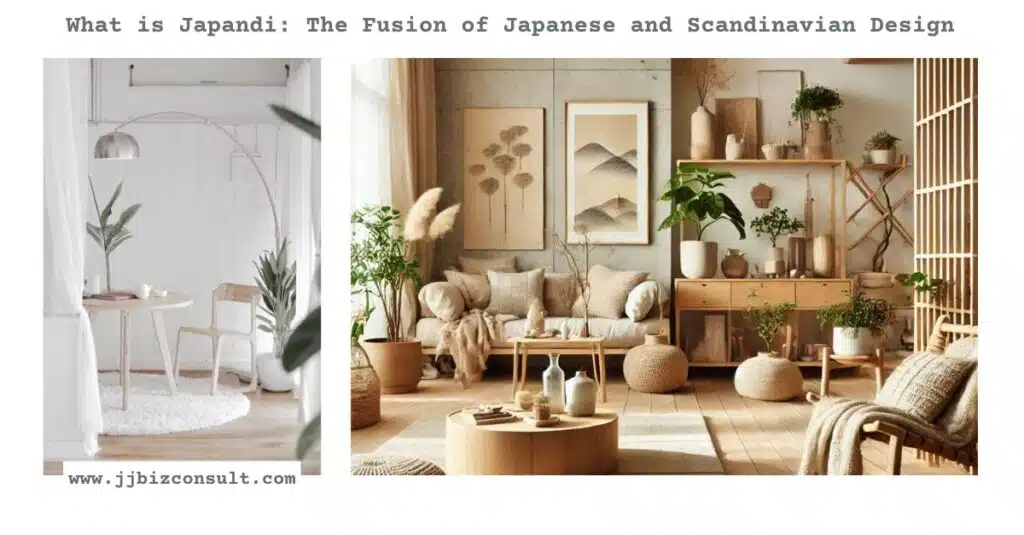
What is Japandi
Japandi is a fusion of Japanese and Scandinavian design styles, creating a harmonious blend that celebrates the best of both worlds. This hybrid aesthetic is characterized by its use of natural elements and colors, resulting in tranquil, minimalist spaces that feel both warm and inviting.
Key Elements of Japandi Design
Japandi design incorporates several key elements that distinguish it from other interior design styles:
- Natural Materials: Japandi spaces often feature materials like stone, light-colored wood, and rattan. These elements bring a touch of nature indoors, creating a serene and organic atmosphere.
- Minimalism: Both Japanese and Scandinavian design philosophies emphasize simplicity and functionality. Japandi embraces this minimalist approach, focusing on clean lines and uncluttered spaces.
- Natural Light: A cornerstone of Japandi design is the use of natural light. Large windows and open spaces allow sunlight to flood in, enhancing the sense of calm and openness.
- Plants: Incorporating plants into Japandi interiors adds a touch of life and vibrancy, while also contributing to the overall sense of tranquility.
Growing Popularity of Japandi
The popularity of Japandi has been on the rise, as evidenced by the increasing search volumes for related items. Over the past two years, searches for “Japandi lamp” have grown by more than 168%, and searches for “Japandi table” have increased by over 42%. This trend indicates a growing interest in this design style, as more people seek to create serene and aesthetically pleasing spaces in their homes.
Japandi in the Context of Organic Modern Style
Japandi is part of a larger design trend known as Organic Modern Style. This meta trend balances natural elements like light wood and plants with modern components such as geometric shapes and metals like brass and iron. The result is a harmonious blend of nature and modernity, creating spaces that are both functional and aesthetically pleasing.
Organic Modern Style: A Rising Trend
The Organic Modern Style has been gaining traction, with platforms like Houzz naming it as a top emerging trend. According to Houzz, searches for organic modern styles have grown 3.5 times year-over-year. Other interior design sites also predict that this style will dominate in 2025. Examples of this trend include organic modern kitchens, bathrooms, and bedrooms, where natural and modern elements are seamlessly integrated.
How does Japandi compare to other minimalist design styles
Japandi design is a unique blend of Japanese and Scandinavian aesthetics, both of which emphasize minimalism, functionality, and natural beauty. When comparing Japandi to other minimalist design styles, several key differences and similarities emerge:
Key Comparisons
1. Origin and Philosophy
- Japandi: Merges Japanese Zen philosophy, which values simplicity and tranquility, with Scandinavian hygge, which emphasizes coziness and warmth.
- Other Minimalist Styles: For example, Modern Minimalism focuses on sleek lines and a more industrial feel, often using materials like metal and glass without the warmth found in Japandi.
2. Use of Natural Materials
- Japandi: Strongly incorporates natural materials such as light woods, stone, and textiles like linen and cotton. This connection to nature is central to its aesthetic.
- Other Styles: While styles like Scandinavian Design also use natural materials, others like Industrial Minimalism may favor raw materials such as exposed brick and metal, which can feel colder.
3. Color Palette
- Japandi: Typically features a muted color palette with earthy tones, soft pastels, and neutrals that promote calmness.
- Other Styles: For instance, Modern Minimalism might use stark contrasts with black and white or bold primary colors for a more dramatic effect.
4. Functionality vs. Aesthetics
- Japandi: Balances functionality with aesthetics; every piece is chosen for its beauty as well as its utility.
- Other Styles: In contrast, some minimalist styles may prioritize aesthetics over functionality, leading to spaces that look good but are less livable.
5. Emphasis on Light
- Japandi: Maximizes natural light through large windows and open spaces to create airy environments.
- Other Styles: While many minimalist designs appreciate light, styles like Mid-Century Modern often incorporate more structured lighting fixtures that can alter the organic feel.
Japandi stands out among minimalist design styles by combining the serene simplicity of Japanese design with the cozy functionality of Scandinavian interiors. Its focus on natural materials, muted color palettes, and a harmonious balance between beauty and utility create spaces that are not only visually appealing but also deeply calming. In contrast to other minimalist styles that may emphasize starkness or industrial elements, Japandi fosters a warm and inviting atmosphere that resonates with those seeking tranquility in their living environments.

What are the best natural materials to use in Japandi interiors
In Japandi interiors, the choice of natural materials plays a crucial role in creating the serene and minimalist aesthetic that defines this design style. Here are some of the best natural materials to use in Japandi interiors:
Best Natural Materials for Japandi Interiors
1. Wood
- Types: Light-colored woods such as oak, pine, and bamboo are commonly used.
- Benefits: Wood adds warmth and texture to spaces, enhancing the natural feel. Its versatility allows it to be used in furniture, flooring, and decorative elements.
2. Stone
- Types: Natural stones like granite, marble, and slate can be incorporated.
- Benefits: Stone surfaces bring an earthy quality to interiors. They can be used for countertops, flooring, or accent walls, adding durability and a sense of permanence.
3. Rattan and Wicker
- Benefits: These materials are lightweight and add a tactile element to the decor. Rattan furniture or accessories can soften spaces while maintaining a minimalist look.
4. Textiles
- Types: Natural fibers such as linen, cotton, and wool are ideal.
- Benefits: These materials contribute to comfort and coziness while promoting breathability. They can be used for curtains, cushions, and upholstery.
5. Clay and Ceramics
- Benefits: Clay pots and ceramic items add organic shapes and textures. They can be used for planters or decorative pieces that enhance the natural aesthetic.
6. Bamboo
- Benefits: Bamboo is a sustainable option that adds an Asian influence to Japandi design. It can be used for flooring, furniture, or decorative accents.
7. Natural Fibers
- Types: Jute, sisal, and hemp are excellent choices for rugs or wall hangings.
- Benefits: These fibers add warmth and texture to the space while being eco-friendly.
Incorporating these natural materials into Japandi interiors creates a harmonious environment that reflects the principles of simplicity and tranquility. By focusing on wood, stone, textiles, and other organic elements, you can achieve a serene space that embodies the essence of Japandi design.
How can you incorporate Japandi elements into your small apartment
Incorporating Japandi elements into a small apartment can create a serene and functional living space. Here are some practical tips to achieve this aesthetic:
Tips for Incorporating Japandi Elements
1. Choose a Neutral Color Palette
- Colors: Opt for soft, muted colors like beige, soft whites, and light grays. These shades create a calm atmosphere and make the space feel larger.
- Accent Colors: Introduce subtle accents using earthy tones such as muted greens or browns to maintain warmth.
2. Use Natural Materials
- Furniture: Select furniture made from natural materials like light wood (e.g., oak or bamboo) and stone. Look for pieces with clean lines and minimal ornamentation.
- Textiles: Incorporate natural fabrics such as linen or cotton for cushions, curtains, and throws to add texture without overwhelming the space.
3. Embrace Minimalism
- Declutter: Keep surfaces clear and limit decorative items to a few meaningful pieces. This approach enhances the minimalist aspect of Japandi design.
- Functional Furniture: Choose multi-functional furniture that serves more than one purpose, such as a coffee table with storage or a sofa bed.
4. Maximize Natural Light
- Window Treatments: Use sheer curtains or blinds that allow natural light to flow in while maintaining privacy.
- Mirrors: Strategically place mirrors to reflect light and create the illusion of a larger space.
5. Incorporate Plants
- Indoor Plants: Add greenery with low-maintenance indoor plants like succulents or snake plants. These not only purify the air but also bring a touch of nature indoors.
- Planters: Use simple ceramic or wooden planters that align with the Japandi aesthetic.
6. Create Cozy Nooks
- Reading Corner: Designate a small area with a comfortable chair, a side table, and good lighting for reading or relaxation.
- Floor Cushions: Use floor cushions or tatami mats to create additional seating options that are both functional and stylish.
7. Focus on Lighting
- Natural Light Sources: Utilize natural light as much as possible during the day.
- Warm Lighting: In the evening, use warm-toned lighting fixtures such as pendant lights or floor lamps with soft bulbs to create an inviting atmosphere.
8. Add Personal Touches
- Art and Decor: Include a few carefully selected art pieces or decor items that reflect your personality while keeping them simple and understated.
- Cultural Elements: Incorporate Japanese or Scandinavian-inspired decor, such as calligraphy art or minimalist sculptures, to enhance the theme.
By thoughtfully incorporating these Japandi elements into your small apartment, you can create a harmonious and tranquil living environment that embodies simplicity and functionality. Focus on natural materials, neutral colors, and minimalism to achieve this serene aesthetic while ensuring your space remains cozy and inviting.
What’s Next for Japandi?
As the Japandi style continues to gain popularity, we can expect to see even more innovative and creative interpretations of this design aesthetic. The emphasis on natural materials, minimalist design, and tranquility makes Japandi a timeless choice that resonates with a wide audience. Whether you’re redesigning your living room or simply looking to add a touch of serenity to your home, Japandi offers a unique blend of Japanese and Scandinavian elements that create a truly harmonious space.
In conclusion, Japandi is more than just a trend—it’s a design philosophy that celebrates the beauty of simplicity and nature. By incorporating elements of both Japanese and Scandinavian design, Japandi creates spaces that are not only visually appealing but also deeply calming and functional. As the demand for this style continues to grow, there’s no doubt that Japandi will remain a staple in the world of interior design for years to come.
Dazzling Desertscapes: Unveiling the Most Expensive Las Vegas Luxury Homes
Amazon Smart Home: Leading the Rise of American Homes, But How Smart Are They?





